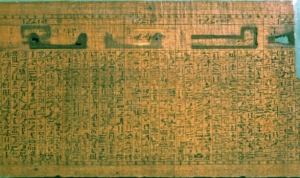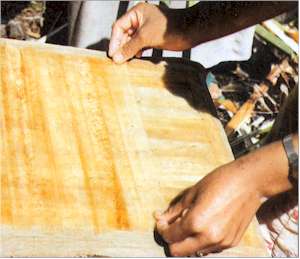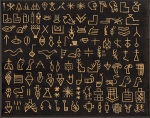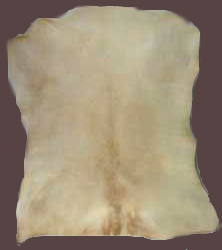Scrolls, in their time, were a revolutionary new technology, and a vast improvement in portability over the clay tablets or stone carvings of earlier times. (However, unlike scrolls, clay tablets managed to survive library fires.)
The Egyptians learned to make papyrus in the fourth millennium B.C.E. Papyrus sheets were made by laying out one vertical layer of papyrus, and one horizontal layer, which were glued together to form sheets. Individual sheets of papyrus paper were between six and nine inches wide, and between twelve and fifteen inches long.
The sheets were glued together, end-to-end, to form a scroll. Writing was done only on the horizontal side , to avoid the difficulty of trying to write across vertical papyrus fibers. A reed pen was used. The papyrus scrolls were rolled so that the horizontal fibers were on the inside.
Ancient writing used no punctuation. It often went from right-to-left, and then left-to-right, just as fields were plowed, so that alternate lines read in opposite directions.
The Phoenicians brought papyrus and writing to Greece between the tenth and ninth centuries B.C.E. Because papyrus degrades in the presence of moisture, those papyrus scrolls which have survived to the present day mostly came from the dry climate of Egypt.
The library at Alexandria ,in Ptolemy’s time, employed many scribes and attempted to borrow and copy every (scroll) book possible, in order to compile the entire knowledge of the known world, that came its way through travelers, ships, and scholars. In order to do so, the prices for papyrus rose. Papyrus was at this time over-harvested, almost to the point of extinction, such were the demands of the great library at Alexandria (500,000 scrolls).
The later competing library, at Pergamon, a Greek city located on today’s west coast of Turkey, contained a library second only to Alexandria’s. Two hundred thousand scrolls were located at Pergamon, compared with 500,000 scrolls at Alexandria. Due to the shortage of papyrus, and perhaps also to lessen dependence on the Egyptians, parchment-making was finally perfected in Pergamon during the second century B.C.E. Later, early Islamic texts were also written on parchment scrolls.
Even though early writing on animal skins began as early as the thirteenth century B.C.E., during reign of Ramses II in Egypt, parchment was not truly perfected until the second century B.C.E., at Pergamon. Pergamon was a Greek city located on today’s west coast of Turkey, which contained a library second only to Alexandria’s.
To make scroll out of parchment, two long rectangles were cut from the treated and stretched skin of animal hide hide, avoiding the spine. Heavy linen thread or animal tendons were used to sew the pieces together. The writing was done with reeds that had to be continually re-trimmed. The reeds were dipped in ink, which was prepared from the soot of olive-oil lamps, mixed with oil, honey, vinegar,and water until it was the perfect consistency. Scrolls were sewed onto wooden rollers at each end, normally with sinew.
Because scrolls could become permanently stained by contact with the oils and dirt on human skin while being read, it became the custom to not touch the scrolls directly. Scrolls were opened to the page wanting to be read or copied using the handles, and placed upon a special cloth while doing so.
In times of war, religious and other scrolls were often buried with the hope of their survival for others to read in the future. They were often protected by being wrapped in linen cloth and then put into sealed jars.
Codices (early, handwritten manuscript books, written on papyrus or parchment) were introduced in the first century C.E. By the third century, use of scrolls and codices were about equal. By the sixth century, codices (books) had replaced scrolls.
_____________________________
History of Paper, Wikipedia, October 15, 2013. http://en.wikipedia.org/wiki/History_of_paper
How Were Scrolls Created? The Dead Sea Scrolls. October 16, 2013. http://maxwellinstitute.byu.edu/dss/creation.html
Papyrus, Wikipedia. October 16, 2013. http://en.wikipedia.org/wiki/Papyrus
Scroll, Wikipedia. October 16, 2013. http://en.wikipedia.org/wiki/Scrolls
Textual Criticism: The Fundamentals. Bible Translation Magazine. ( Vol. 28, October 2013 Issue.) October 16, 2013. http://bible-translation.net/page/fundamental-of-textual-criticism
Thompson, Jack C. On Restoring Sacred Objects. (1998) Wikipedia. http://en.wikipedia.org/wiki/Scrolls







Recent Comments